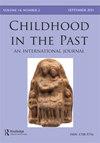从社会空间到训练场——二十世纪上半叶匈牙利儿童公共领域设计理论的演变
IF 0.5
Q3 ANTHROPOLOGY
引用次数: 1
摘要
摘要二十世纪上半叶,匈牙利的政治和社会发生了动荡的变化。几十年内,该国从奥匈帝国的合作伙伴转变为短命的匈牙利共和国,后来又转变为苏联共和国,最终成为独立的匈牙利王国。这些变化强烈影响了生活各个领域的意识形态,包括景观建筑和教育理论与实践。本文讨论了匈牙利在国际教育背景下为儿童设计场所的不断发展的想法,遵循游戏空间的不断变化的概念,从体育和健康设计到为即将到来的战争训练士兵的想法。通过追踪这些与20世纪初匈牙利历史之间的复杂联系,本文认为设计理论的交织性质和儿童空间的社会政治背景是理解儿童空间发展的关键。本文章由计算机程序翻译,如有差异,请以英文原文为准。
From Social Spaces to Training Fields: Evolution of Design Theory of the Children’s Public Sphere in Hungary in the First Half of the Twentieth Century
ABSTRACT The first half of the twentieth century brought turbulent changes into the political and social scene of Hungary. Within a few decades the country shifted from being a partner in the Austro-Hungarian Monarchy, to the short-lived Hungarian – and later Soviet – Republic and ultimately to the independent Kingdom of Hungary. These changes strongly affected the ideologies of all fields of life, including landscape architectural and educational theory and practice. This paper discusses evolving Hungarian ideas about designing places for children in the international context of education, by following the changing concepts of play spaces, from designing for physical education and health, to the idea of training soldiers for an approaching war. By tracing the intricate links between these and the history of Hungary in the early twentieth century, the paper argues that the interwoven nature of design theory and the socio-political context of children’s spaces is key in understanding their development.
求助全文
通过发布文献求助,成功后即可免费获取论文全文。
去求助
来源期刊

Childhood in the Past
Social Sciences-Anthropology
CiteScore
0.90
自引率
0.00%
发文量
16
期刊介绍:
Childhood in the Past provides a peer-reviewed, interdisciplinary, international forum for the publication of research into all aspects of children and childhood in the past, which transcends conventional intellectual, disciplinary, geographical and chronological boundaries. The editor welcomes offers of papers from any field of study which can further knowledge and understanding of the nature and experience of childhood in the past.
 求助内容:
求助内容: 应助结果提醒方式:
应助结果提醒方式:


